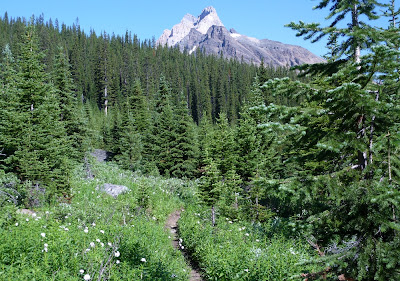The Big Larches trail emerges from the woods surrounding Lake O'Hara and Mary Lake and skirts the edge of a vast rockfall, where it begins to climb.
Eventually it turns to the right and dives deeper into the larches for which the trail is named.
We passed the trail to All Souls Prospect on our left, then soon, at the outlet from Schäffer Lake, merged with the trail arriving from the Elizabeth Parker Hut. From here, Joan and I took the route to Lake McArthur that passes near the sign-in for the Odaray Highline Trail, established for the benefit of wildlife passing through the choke point of McArthur Pass. To quote Parks Canada,
Adjacent to McArthur Valley and contributing to the corridor is the Odaray Plateau. Habitat here is used seasonally by several species, including grizzly bears and mountain goats. The plateau is closed in summer to protect habitat and to limit disturbance in the wildlife corridor.The Odaray Highline Trail cuts across the pass, skirting the closed zone. There is a voluntary program to limit the number of groups that use this trail; when we were there, the check-in station requested no more than four groups per day until August 15th, and no more than two after that. This makes grabbing an Odaray Grandview slot difficult, because hikers in the campground can get started earlier then hikers from the lodge. Note: this Parks Canada web page, updated September 2nd, 2014, now requests only two groups until August 15th, and zero after that.
Because the program is only voluntary, we've seen lots of people violating it, but we do not. The bears were here first. This means that we haven't been able to visit Odaray Grandview for several years. (Many wonder at the efficacy of a voluntary program: how much does it really accomplish?)
This year we were lucky. After passing the guard marmot
we checked the sign-in book, and there was an open slot for us! Lake McArthur could wait for another day.
Wanting to do the right thing, we waited to see if any other hikers wishing to take the Highline would show up. We could form a single group, you see, and all could go. And not long afterwards, a group of two moms and four kids arrived.
They decided they would join us. The Highline, after crossing the pass, makes a right turn, wanders through some rocks, and then begins a gentle climb on the lower slopes of Odaray. The view begins to open up.
Then the trail arrives at the point where the Odaray Plateau is closed. The only way to go is up, to the Grandview, on a steep trail that occasionally demands a handhold. However, it's not exceptionally long, and the view at the top is rewarding. Joan and I pulled ahead of the family group, but for some reason I didn't take any photos until we got to the top.
There, the view is a jaw-dropper.
The valley on the left holds the fire road down to the TransCanada Highway. In the middle is Lake O'Hara, surrounded by peaks. A bit further right is Schäffer Lake and a meadow. Visible at far right, in its bowl, is Lake McArthur. Zooming in, my camera can even pick out hikers atop All Souls Prospect!
There are plenty of loose stones of all sizes on the Grandview's bench. Rock piles created by hikers and climbers have gone far beyond simple cairns in the last decade.
Joan provides scale for this stone windbreak, useful for staying warm and keeping sandwiches in hand when winds come howling up the pass.
We ate our lunch up here, and never saw the family group. On our way back along the bench, before the trail starts seriously descending, we saw them arriving at the descent point from the other direction along the bench. Hmm. We had never been over to the other side. Perhaps something was there?
Yes indeed, a spectacular look into the Duchesnay Basin. How could we have overlooked this?!
In the foreground, there's the best view of the Morning Glory Lakes that I've ever had. Beyond a rise, you can see much of Linda Lakes. On the far side of the basin rises Cathedral Mountain, and below it the mixed rock faces and trees of the Cathedral Prospect, which we've hiked before.
On our return descent we caught up to the family group, and we all stopped for a snack. Then we spotted ptarmigans, at least one parent,
and one chick.
We continued retracing our steps to our cabin, and enjoyed another fine dinner at the lodge. On an evening lakeside stroll, I took several photos of the Sufi Bench,
which I've discussed in detail at the end of this post. My photos of the bench allow Bob to keep an eye on its condition.


























































